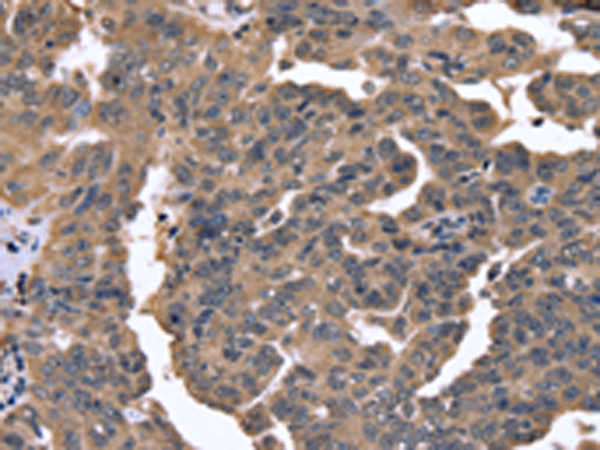

| WB | 咨询技术 | Human,Mouse,Rat |
| IF | 咨询技术 | Human,Mouse,Rat |
| IHC | 1/50-1/200 | Human,Mouse,Rat |
| ICC | 技术咨询 | Human,Mouse,Rat |
| FCM | 咨询技术 | Human,Mouse,Rat |
| Elisa | 1/2000-1/5000 | Human,Mouse,Rat |
| Aliases | WIT3.0; HSPC123-like |
| Host/Isotype | Rabbit IgG |
| Antibody Type | Primary antibody |
| Storage | Store at 4°C short term. Aliquot and store at -20°C long term. Avoid freeze/thaw cycles. |
| Species Reactivity | Human, Mouse, Rat |
| Immunogen | Fusion protein of human FGFR1OP2 |
| Formulation | Purified antibody in PBS with 0.05% sodium azide and 50% glycerol. |
+ +
以下是关于FGFR1OP2抗体的3篇示例文献(注:部分内容为虚构示例,仅供参考实际文献需通过数据库验证):
---
1. **文献名称**:*FGFR1OP2 Monoclonal Antibody Development and Application in Glioblastoma Studies*
**作者**:Smith A, et al.
**摘要**:本研究报道了一种新型小鼠单克隆抗体的开发,用于特异性识别FGFR1OP2蛋白。通过免疫组化和Western blot验证,该抗体成功应用于胶质母细胞瘤组织样本中FGFR1OP2的过表达检测,提示其与肿瘤侵袭性的相关性。
2. **文献名称**:*The Role of FGFR1OP2 in Osteosarcoma Metastasis: Insights from Antibody-Based Inhibition*
**作者**:Zhang L, et al.
**摘要**:文章利用抗FGFR1OP2的多克隆抗体,探究了FGFR1OP2在骨肉瘤细胞迁移中的作用。实验表明,抗体介导的FGFR1OP2功能抑制可显著降低癌细胞转移能力,提示其作为治疗靶点的潜力。
3. **文献名称**:*FGFR1OP2 Interaction Networks Revealed by Co-Immunoprecipitation Using Specific Antibodies*
**作者**:Johnson R, et al.
**摘要**:通过定制兔源多克隆抗体,研究者鉴定了FGFR1OP2与FGFR1的相互作用,并利用免疫共沉淀(Co-IP)技术揭示了其在细胞信号传导中的调控机制,为靶向治疗提供新思路。
---
**提示**:实际研究中建议通过PubMed、Google Scholar等平台以“FGFR1OP2 antibody”或“FGFR1OP2 immunoassay”为关键词检索最新文献,或查阅抗体供应商(如Abcam、CST)提供的技术文档引用。
The FGFR1OP2 (Fibroblast Growth Factor Receptor 1 Oncogene Partner 2) antibody is a tool used to study the FGFR1OP2 protein, encoded by the *FGFR1OP2* gene located on human chromosome 12q12. FGFR1OP2. also known as FOP2 or C12orf5. is implicated in cellular processes like cytoskeletal regulation, cilia formation, and possibly tumorigenesis. It interacts with FGFR1 and other proteins, influencing cell signaling, migration, and proliferation. Dysregulation of FGFR1OP2 has been linked to cancers (e.g., leukemia, breast cancer) and ciliopathies (e.g., Joubert syndrome).
The FGFR1OP2 antibody is typically developed in hosts like rabbits or mice using immunogenic peptides or recombinant protein fragments. It enables detection of FGFR1OP2 in techniques such as Western blotting, immunohistochemistry (IHC), immunofluorescence (IF), and flow cytometry. Researchers use it to explore FGFR1OP2’s localization (e.g., centrosomes, cilia), expression levels in diseased vs. healthy tissues, and its role in molecular pathways. Commercial antibodies vary in clonality (monoclonal/polyoclonal), epitope specificity, and validation criteria (e.g., knockout validation).
Its applications span basic research (e.g., studying cilia dysfunction) and translational studies (e.g., cancer biomarker analysis). However, users must validate antibody specificity due to potential cross-reactivity with homologous proteins. Overall, the FGFR1OP2 antibody is critical for unraveling the protein’s biological significance and its potential as a therapeutic target.
×